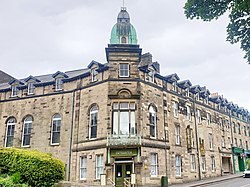Buxton Museum and Art Gallery
| Buxton Museum and Art Gallery | |
|
Derbyshire | |
|---|---|

| |
| Type: | Museum |
| Location | |
| Grid reference: | SK05907333 |
| Location: | 53°15’25"N, 1°54’47"W |
| Town: | Buxton |
| History | |
| Built 1880 | |
| Museum | |
| Information | |
| Website: | Buxton Museum |
Buxton Museum and Art Gallery stands on Terrace Road, off the Market Square, in Buxton, the 'Queen of the Peak', in Derbyshire. The museum is established in a grand building built as the Peak Hydropathic Hotel in 1880.
During the First World War, the Red Cross used the Peak Hydropathic Hotel to care for wounded Canadian soldiers.
In 1928, the Buxton Free Public Library and Museum moved into the building, leaving the Town Hall.[1]
The museum today focuses its collection on history, geology and archaeology primarily from the Peak District and Derbyshire.[2]
Permanent collections
The museum's permanent collections include:
- Carboniferous limestone fossil record of the Peak District collected between 1900 and 1950;
- Pliocene mammal evidence from caves and quarries throughout the Peak District;
- The archives of archaeologist Sir William Boyd Dawkins and geologist Dr John Wilfrid (J.W.) Jackson, geologists associated with the county and with Manchester Museum;
- Randolph Douglas 'House of Wonders' collection from Castleton which includes a large collection of locks and keys and some unusual Harry Houdini material;
- A Buxton photographic collection, a collection of local social history and ephemera, and a collection of Houdini materials;
- A fine art collection dominated by 19th and 20th century works in watercolours, oils and prints, including works by Sir Frank Brangwyn, Marc Chagall and Edgar Chahine.
Amongst the minerals are Derbyshire Blue John, carved limestone, local specimens, and cave deposits. In 2006, Buxton Museum purchased a rare collection of decorative Ashford Black Marble wares, together with tools used to work the stone collection left by John Michael Tomlinson.[3] Other collections relating to Derbyshire, also managed from Buxton Museum and Art Gallery, include a Derbyshire Police Collection.
The museum's permanent galleries include the recreated Boyd Dawkins Study and the ‘Wonders of the Peak’ gallery. Dawkins bequeathed to the Museum a complete Victorian study containing his furniture, scientific instruments, books, Oriental ware and fossil collection. The ‘Wonders of the Peak’ gallery was redesigned and relaunched in September 2017. It explores Peak District history from the Lower Carboniferous to the present day. There are also two temporary exhibition galleries displaying a changing programme of work by visiting artists or drawn from the museum's own collections.
Outside links
References
- ↑ "Welcome to Buxton Museum & Art Gallery, 2012 pamphlet published by the museum.
- ↑ Buxton Museum and Art Gallery
- ↑ "Rare Ashford Black Marble Returns To Buxton Museum". Culture244. http://www.culture24.org.uk/art/art33722. Retrieved 24 February 2011.